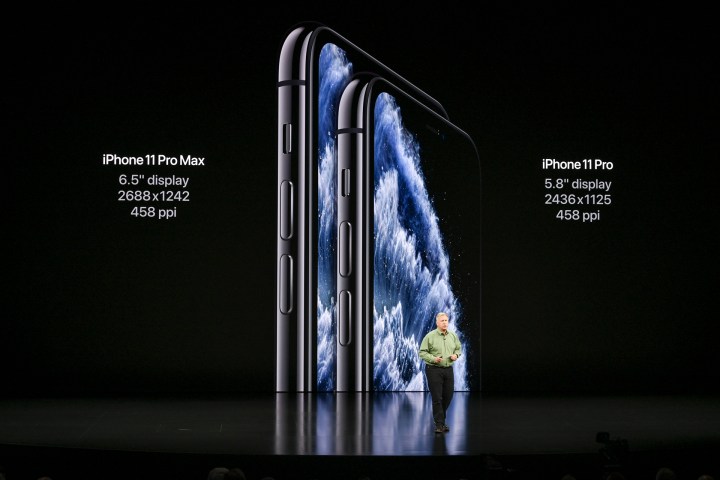Meet the latest fruit from the Apple tree: the iPhone 11 family. Apple announced the iPhone 11, 11 Pro, and 11 Pro Max at a special event on Sept. 10, 2019, on its futuristic campus in Cupertino, California. The new phones replaces the iPhone XR, iPhone XS and iPhone XS Max family of devices, which were released at the end of 2018.
“We’ve always believed by giving people wonderful tools, you enable them to do wonderful things,” said Apple CEO Tim Cook at the beginning of the event.
The new naming structure means the iPhone 11 is now the entry-level phone, and should be considered this year’s iPhone XR — the first steps into the iPhone line up. The iPhone 11 Pro is the new iPhone XS, and the 11 Pro Max is this year’s iPhone XS Max. That should clear things up, and the introduction of the Pro name — which Apple says refers to the camera setup’s quality and ability — makes the line-up easier to understand. Here’s everything you need to know about the iPhone 11. (You can also check out our first impressions in our iPhone 11 review.)
Apple iPhone 11

The new baby of the iPhone family is the iPhone 11. The body is made of glass and aluminum, while the twin-lens camera bump is made from a single piece of glass. It comes in six different colors, including a great yellow, a subtle purple, a green, black, white, and a special red version. It has a 6.1-inch Liquid Retina, True Tone display, plus spatial audio and Dolby Atmos for a great movie experience.
The camera has two lenses, made up of a 12-megapixel wide-angle camera and a 12-megapixel ultra-wide camera. Apple has also added a new Night Mode that automatically activates when the light is low, and a slow-motion video mode. Enhancements have been made to the video mode, with improved stabilization, as well as 4K resolution at 60fps.
The iPhone 11 uses the new A13 Bionic processor, which Apple claims is the fastest processor ever in a smartphone, and is 20% faster than the A12 Bionic inside the previous generation iPhone models. Face ID is 30% faster than before, with improvements in performance over distance and at different angles. The phone’s battery will provide an hour more use over the iPhone XR, and it comes with wireless charging too.
The new iPhone 11 will start at $700, a lower price than the original price of the iPhone XR. It is currently available for pre-order, and deliveries will start on September 20 when the phone fully releases.
Apple iPhone 11 Pro and 11 Pro Max

Apple’s flagship phones for 2019 are the iPhone 11 Pro and the 11 Pro Max. The iPhone 11 Pro models are made of stainless steel, and the back from a single piece of glass with a matte finish. It comes in a stunning midnight green, space gray, silver, and a new gold finish. It has a new screen called the Super Retina XDR that comes in two sizes, the 5.8-inch 11 Pro and 6.5-inch 11 Pro Max, with the new OLED panel delivering a brightness of 1,200 nits. Movies will be great with spatial audio sound, Dolby Vision and Atmos, as well as HDR10.
Like the iPhone 11, the 11 Pro models use the Apple A13 Bionic processor. Apple says it is a low-power design, built around a 7nm platform containing 8.5 billion transistors. The battery lasts four more hours in the iPhone 11 compared to the iPhone XS, and five hours more in the iPhone 11 Pro. It comes with a fast charger in the box. The phone has improved water and dust resistance, faster cellular connection than before, and wireless charging.

The triple-lens camera has new 12-megapixel wide, ultra-wide and telephoto lenses, all controlled by a new image signal processor. The camera offers a 2x zoom, Night Mode, Smart HDR, and a new True Tone flash unit.
One new camera feature is called Deep Fusion technology, which uses machine learning to shoot nine images, four before you have even pressed the shutter button. Going through the image pixel-by-pixel, it generates the best possible image. It will arrive as an update in the fall. On the front is a 12-megapixel TrueDepth selfie camera with a wider view, and the chance to shoot 4K video at both 4K resolution, and in slow motion. The same improvements to Face ID from the iPhone 11 will come to the 11 Pro and 11 Pro Max.
The iPhone 11 Pro starts at $999, and the 11 Pro Max at $1,099. Pre-orders began at 5 a.m. PT on on Friday September 13, and the new phones ship out on September 20. Apple will also release a series of new cases, including transparent ones.
What else?

Apple will include a year’s subscription to its new Apple TV+ service with every new iPhone purchased too. Apple TV+ will launch on November 1. Apple also provided more details on Apple Arcade, its game-focused subscription package, which will contain more than 100 exclusive games at launch. It’ll launch on September 19 in more than 150 countries, at a cost of $5 per month for complete access.
Updated on September 13, 2019: The iPhone 11 is now available for pre-order.



